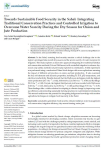Ayoumbissi Keugmeni G.A., Keita A., Yonaba R., Sawadogo B., Kengni L. (2025). Towards sustainable food security in the Sahel: integrating traditional conservation practices and controlled irrigation to overcome water scarcity during the dry season for onion and jute production. Sustainability, 02/03/2025, vol. 17, n. 6, p. 2345.
https://doi.org/10.3390/su17062345
https://doi.org/10.3390/su17062345
| Titre : | Towards sustainable food security in the Sahel: integrating traditional conservation practices and controlled irrigation to overcome water scarcity during the dry season for onion and jute production (2025) |
| Auteurs : | G.A. Ayoumbissi Keugmeni ; A. Keita ; R. Yonaba ; B. Sawadogo ; L. Kengni |
| Type de document : | Article |
| Dans : | Sustainability (vol. 17, n. 6, March 2025) |
| Article en page(s) : | p. 2345 |
| Langues : | Anglais |
| Langues du résumé : | Anglais |
| Catégories : |
Catégories principales 06 - AGRICULTURE. FORÊTS. PÊCHES ; 6.4 - Production Agricole. Système de ProductionThésaurus IAMM PRATIQUE AGRICOLE ; DURABILITE ; MODE DE CULTURE ; CONSERVATION DES SOLS ; IRRIGATION ; METHODE D'IRRIGATION ; AGRICULTURE TRADITIONNELLE ; TECHNOLOGIE TRADITIONNELLE ; SAHEL |
| Résumé : | In the Sahel, ensuring food security remains a critical challenge due to the region's prolonged nine-month dry season and the severe scarcity of water resources for irrigation. This study explores an innovative approach integrating two traditional Sahelian soil conservation methods (Zaï and Half-moon) with controlled irrigation to enhance dry-season crop yields, methods not previously explored in combination. A field experiment was performed using a randomized Fisher block design with seven replications assessing the impact of different soil practices on onion and jute production. It also examined the key soil elements and dynamic properties, including N, P, K, pH, temperature, and electrical conductivity. Results showed that the Half-moon technique yields the highest onion production (20.1 t ha-1 + 0.82), followed by Zaï (18.6 t ha-1 + 0.48) and flat tillage (14.2 t ha-1 + 0.84). For jute, the highest third-harvest yield was recorded with Half-moon (9.68 t ha-1 + 0.63), followed by Zaï (9.56 t ha-1 + 0.48) and flat tillage (7.53 t ha-1 + 0.37). These findings offer a viable solution for adapting to climate change by improving water use efficiency and promoting sustainable farming practices in water-limited environments. This research underscores the potential for integrating indigenous knowledge with modern agricultural techniques to mitigate food insecurity in the Sahel. |
| Cote : | En ligne |
| URL / DOI : | https://doi.org/10.3390/su17062345 |







